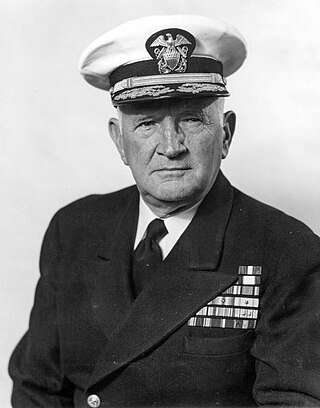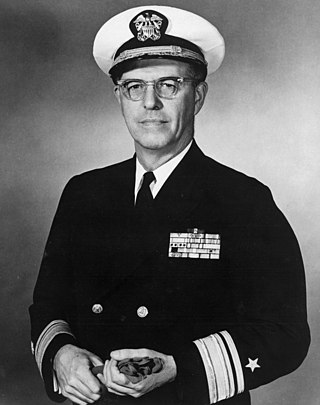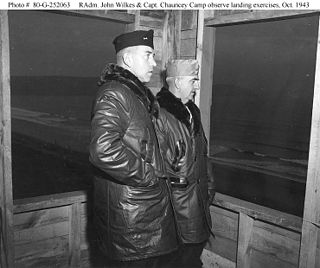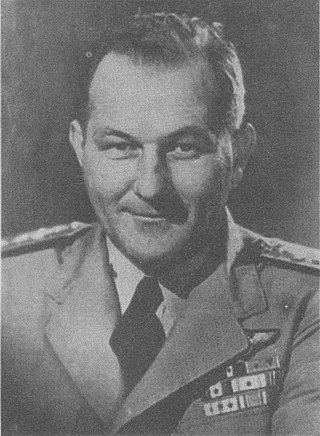
The Sixth Fleet is a numbered fleet of the United States Navy operating as part of United States Naval Forces Europe-Africa. The Sixth Fleet is headquartered at Naval Support Activity Naples, Italy. The officially stated mission of the Sixth Fleet in 2011 is that it "conducts the full range of Maritime Operations and Theater Security Cooperation missions, in concert with coalition, joint, interagency, and other parties, in order to advance security and stability in Europe and Africa." The current commander of the Sixth Fleet is Vice Admiral Thomas E. Ishee.

Jesse Barrett "Oley" Oldendorf was an admiral in the United States Navy, famous for defeating a Japanese force in the Battle of Leyte Gulf during World War II. He also served as commander of the American naval forces during the early phase of the Battle of the Caribbean. In early 1942, a secret group of senior Navy officers empaneled by President Franklin D. Roosevelt assessed him as one of the 40 most competent of the 120 flag officers in the Navy.

The First Fleet was a numbered fleet of the United States Navy, in operation from January 1947 to 1 February 1973 in the western Pacific Ocean as part of the Pacific Fleet. In 1973, it was disestablished and its duties assumed by the United States Third Fleet.

Vice Admiral Robert Lee Ghormley was an admiral in the United States Navy who served as Commander, South Pacific Area during World War II. Ghormley was long considered to be an ineffective leader–overly cautious, pessimistic, and even defeatist–but recent scholarship has shown that while he may not have been an inspiring leader, he performed well under difficult circumstances.

The South Pacific Area (SOPAC) was a multinational U.S.-led military command active during World War II. It was a part of the U.S. Pacific Ocean Areas under Admiral Chester Nimitz.

United States Naval Forces Europe and Africa (NAVEUR-NAVAF), is the United States Navy component command of the United States European Command and United States Africa Command. Prior to 2020, NAVEUR-NAVAF was previously referred to as United States Naval Forces Europe – Naval Forces Africa and sometimes referred to as United States Naval Forces Europe – Africa.

The U.S. Fourth Fleet is a United States Navy numbered fleet. It is the Naval Component Command of U.S. Southern Command (USSOUTHCOM). The Fourth Fleet is headquartered at Naval Station Mayport in Jacksonville, Florida. It is responsible for U.S. Navy ships, aircraft and submarines operating in the Caribbean Sea, and the Atlantic and Pacific Oceans around Central and South America.

Rear Admiral Draper Laurence Kauffman was an American underwater demolition expert, who served during the 1960s as 44th Superintendent of the United States Naval Academy. During World War II, he organized the first U.S. Navy Combat Demolition Units from which the SEALs and Navy Explosive Ordnance Disposal (EOD) would evolve. His wartime service also included participation in the invasions of Saipan, Tinian, Iwo Jima, and Okinawa.

U.S. Naval Forces Japan/Navy Region Japan (CNFJ/CNRJ) is a dual-hatted command with command and control authority of all shore installations and assigned forces of the United States Navy in Japan as well as the responsibility to liaise with the Japanese Maritime Self-Defense Force (JMSDF). It is currently headquartered in Yokosuka, Japan, onboard United States Fleet Activities Yokosuka and is commanded by Rear Admiral Brian P. Fort, USN. CNFJ/CNRJ's area of responsibility extends from the southern tip of the Kamchatka peninsula to the northern tip of Taiwan and, the Singapore area of operations, and the Indian Ocean British Territory of Diego Garcia, but excludes the Korean peninsula.
Sea Frontiers were several, now disestablished, commands of the United States Navy as areas of defense against enemy vessels, especially submarines, along the U.S. coasts. They existed from 1 July 1941 until in some cases the 1970s. Sea Frontiers generally started at the shore of the United States and extended outwards into the sea for a nominal distance of two hundred miles.

The Eastern Sea Frontier (EASTSEAFRON) was a United States Navy operational command during World War II, that was responsible for the coastal waters from Canada to Jacksonville, Florida, extending out for a nominal distance of two hundred miles. The Commander was designated Commander, Eastern Sea Frontier (COMEASTSEAFRON). COMEASTSEAFRON had vessels for convoy use or other uses determined by the commander. In addition to providing escorts for convoys within its frontier, the frontier was responsible for sea-air rescue, harbor defense, shipping lane patrol, minesweeping, and air operations.

Felix Budwell Stump was an admiral in the United States Navy and Commander, United States Pacific Fleet from July 10, 1953 until July 31, 1958.

John E. Wilkes was a vice admiral in the United States Navy, who served in World War I and World War II. In December 1941 he was appointed Commander of Submarines, Asiatic Fleet. In 1944 Wilkes was commander of all ports in Northern Europe. From 1945 to 1951 he was the chief U.S. Naval Officer in Occupied Germany. He retired in 1951.

Bertram Joseph Rodgers was a highly decorated vice admiral in the United States Navy during World War II. He received his Navy Cross as captain of USS Salt Lake City in the battle of the Komandorski islands, during the Aleutian Islands Campaign.

British Naval Forces Germany was a command of the Royal Navy that was active from 1944 to 1961 under three titles.

Austin Kelvin Doyle was an American naval officer, admiral, chief of United States Taiwan Defense Command and Naval Air Training Command. During World War II, he served as United States Navy captain of the escort carrier USS Nassau and the fleet carrier USS Hornet, earning the Navy Cross twice. After serving in the US Navy for forty years, Doyle retired in 1958. He also served as a rear admiral.

Frederick Joseph "Fritz" Harlfinger II was a United States Navy officer who served as a submarine commander during World War II and later commanded the South Atlantic Force of the U.S. Atlantic Fleet. He then served as director of the Office of Naval Intelligence and finally as director of Command Support Programs in the Office of the Chief of Naval Operations, with the rank of vice admiral.

















